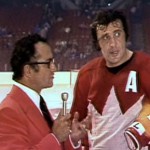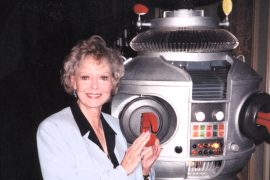News of Annette Funicello’s passing Monday at age 70 sent me scrambling through a box of old cassette tapes. Thanks to my friend Lorraine Santoli, a former Disney publicity manager who authored a book on the Mouseketeers and who formed a close bond with Funicello, I was able to interview the Disney princess. That memorable conversation occurred twenty years ago in 1993 at the house she shared in the Hollywood Hills with second husband Glen Holt.
The actress, who at the time showed few symptoms, had just gone public with the news she was suffering from the neurological disorder multiple sclerosis.
Listening to the tape, her voice comes back strong and unwavering, but only a few short years later that was no longer the case. Funicello lived 25 years with MS and while the disease left her ravaged beyond recognition and completely dependent, her condition had stabilized in recent months according to CTV medical correspondent Avis Favaro.
Favaro traveled to Los Angeles last fall to record a special episode of W5 focusing on Funicello’s condition. (You can stream it here at CTV.ca.) Fans had not seen the former child star in quite a while and it was shocking to see what had become of her. Holt wanted the world to see in hopes it would spur fund raising efforts to find a cause and a cure.
Those efforts continue; donations can be made here at the Annette Funicello Research Fund for Neurological Diseases.
The actress first noticed a weakness in her legs while shooting Back to the Beach in 1987 with her frequent co-star Frankie Avalon. After hiding her condition with tales of tendinitis, she decided to head off the tabloids and tell her side of the story, first to USA Today and then to People magazine.
While Funicello’s hilltop Hollywoodbungalow in 1993 contained several dolls and teddy bears (she developed her own line of both in the ‘90s), there were precious few mementos from her time as Disney’s main mouseketeer.
“Who knew that stuff would be so collectible some day?” she said. An Annette lunch box over on a shelf had been purchased from a collector. When she inquired about her original Mouse Club ears, she learned they had been stolen from the Disney archives.
Funicello said the hardest part about being a child star was not being able to go shopping with her friends. “I’d be trying out clothes in a stall and people were banging on the door asking for autographs,” she said. “It was weird. I remember saying to my parents, ‘Why me?’ I certainly wasn’t the best singer or dancer. The other kids are so good, why is this happening to me?”
She credits her parents for keeping her feet on the ground. “They never treated me any different than from my brother,” she says.
Being busy all the time also helped. “Most of the time I was working seven days a week,” she said. “Five on the Mickey Mouse Club and on the weekends at Disneyland.” Uncle Walt kept the kids hopping, but Funicello remembered “Mr. Disney” as “wonderful and supportive. I don’t know what he’s like in a conference room or with other people making a deal. I know him to be a very kind sensitive man and one who loves children. He was able to being out the child in all of us through his parks and made the world a better place.”
Being a former child star was no Disney dream for a lot of other kids. Funicello recalled doing a TV show shortly before our interview with two former stars whose names she didn’t mention. “And I’m sitting in the middle and they’re telling how their parents had them on drugs,” she says. “Another one said, ‘I hated it, I hated every minute of it,’ and I’m telling about my wonderful experience. And I must have sounded like Pollyanna. I said, ‘You must think I an making this up, but it was one of the happiest days of my life. We were all just so happy working, it was your home away from home. It was magic.'”
Strange then how her life took such a cruel turn, how she suffered a fate far worse than being overwhelmed by fame and fortune. Few could have borne Funicello’s cross with such spirit and dignity. She truly took the good luck with the bad.
 |
| Funicello with Tommy Sands in Babes in Toyland |
Funicello was also an exception in that her career extended almost seamlessly from childhood roles to young adult. She was the only mouseketeer Disney kept under a studio contract after the series went out of production after three seasons. She appeared in a string of wholesome Disney family movies, including her favourite, the 1961 remake Babes in Toyland.
“That was a six month schedule,” she recalled. “Three months to rehearse and three months to film.”
It took a little longer to master the singing scenes in Victor Herbert’s light opera. “It was the most frightened I’ve ever been,” she said. Co-star Tommy Sands “had this wonderful voice. I can’t sing!” she insisted, despite recording dozens of albums and hits such as Tall Paul and Pineapple Princess.
All those vocal demands didn’t stop her from going after the part. “I saw all these pretty blonds and red heads going into the studio,” she recalled. She learned that they were testing for the part of Mary Mary Quite Contrary.
Finally she got a call to report to hair and make up because Disney wanted to see how she looked as a red head. Funicello got the part and said she was thrilled to change her hair colour. “I didn’t want to change it back afterwards.”
Towards the end of her Disney contract, Funicello was loaned out to begin shooting a series of beach party movies that became as much a sign of the early ’60s as Pat Boone, Fabian and American Bandstand. They were cheeky yet wholesome, an idealized, parent’s image of America that fell between Elvis’ original sneer and the social unrest of the Vietnam War years.
 I asked her if she was ever tempted to shake things up, to play a bad girl. “Other people were more interested in changing my image than I was,” she said. “After I did the beach pictures, about seven or eight of them, scripts started coming to my house where I would play either a doper or a hooker. Notes attached to the script would say, ‘We can change your image.’ After reading 25 or 30 pages, I’d close it up, sent it back and say, ‘No thank you.'”
I asked her if she was ever tempted to shake things up, to play a bad girl. “Other people were more interested in changing my image than I was,” she said. “After I did the beach pictures, about seven or eight of them, scripts started coming to my house where I would play either a doper or a hooker. Notes attached to the script would say, ‘We can change your image.’ After reading 25 or 30 pages, I’d close it up, sent it back and say, ‘No thank you.'”Unlike a later Mousketeer, Britney Spears, Funicello said she never had any desire to, as people would say today, alter her brand. “I made sure that this credibility that I had built up over the years has never been tarnished,. I respect the Disney name so much I didn’t want to do anything to tarnish that.”
Towards the end of our interview, Funicello’s parents came in. Wished I had interviewed them now, they were the ones who saw it all, who made sure Paul Anka behaved himself, who shared the dizzying highs and the heartbreaking lows.
Annette truly lived the American Dream, right down to the nightmare finish. Not even as master a storyteller as Walt Disney could have made up such an outrageous story. Her fame and her suffering take the concept of luck and fortune and stretches them beyond the breaking point. She’ll endure as a cheerful icon of Disney innocence, but also as a brave example of dignity and hope. It’s a legacy that will forever hold her banner high.
Besides her beloved husband Holt, she leaves behind three children, three grandchildren and many, many fans. Read more at this tribute I wrote appearing in today’s Toronto Star.








